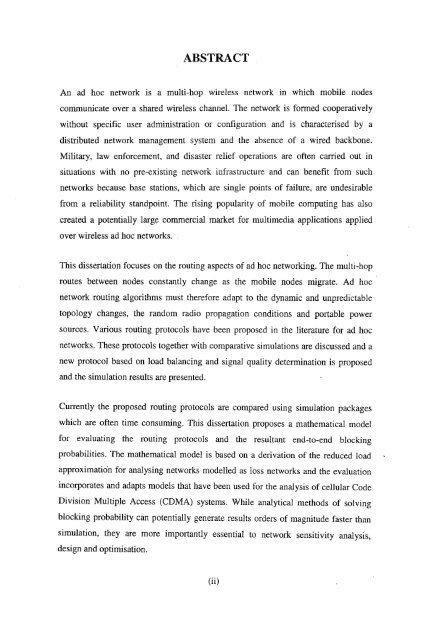Gugrajah_Yuvaan_ Ramesh_2003.pdf
Gugrajah_Yuvaan_ Ramesh_2003.pdf
Gugrajah_Yuvaan_ Ramesh_2003.pdf
You also want an ePaper? Increase the reach of your titles
YUMPU automatically turns print PDFs into web optimized ePapers that Google loves.
ABSTRACT<br />
An ad hoc network is a multi-hop wireless network in which mobile nodes<br />
communicate over a shared wireless channel. The network is formed cooperatively<br />
without specific user administration or configuration and is characterised by a<br />
distributed network management system and the absence of a wired backbone.<br />
Military, law enforcement, and disaster relief operations are often carried out in<br />
situations with no pre-existing network infrastructure and can benefit from such<br />
networks because base stations, which are single points of failure, are undesirable<br />
from a reliability standpoint. The rising popularity of mobile computing has also<br />
created a potentially large commercial market for multimedia applications applied<br />
over wireless ad hoc networks.<br />
This dissertation focuses on the routing aspects of ad hoc networking. The multi-hop<br />
routes between nodes constantly change as the mobile nodes migrate. Ad hoc<br />
network routing algorithms must therefore adapt to the dynamic and unpredictable<br />
topology changes, the random radio propagation conditions and portable power<br />
sources. Various routing protocols have been proposed in the literature for ad hoc<br />
networks. These protocols together with comparative simulations are discussed and a<br />
new protocol based on load balancing and signal quality determination is proposed<br />
.and the simulation results are presented.<br />
Currently the proposed routing protocols are compared using simulation packages<br />
which are often time consuming. This dissertation proposes a mathematical model<br />
for evaluating the routing protocols and the resultant end-to-end blocking<br />
probabilities. The mathematical model is based on a derivation of the reduced load<br />
approximation for analysing networks modelled as loss networks and the evaluation<br />
incorporates and adapts models that have been used for the analysis of cellular Code<br />
Division Multiple Access (CDMA) systems. While analytical methods of solving<br />
blocking probability can potentially generate results orders of magnitude faster than<br />
simulation, they are more importantly essential to network sensitivity analysis,<br />
design and optimisation.<br />
(ii)
















